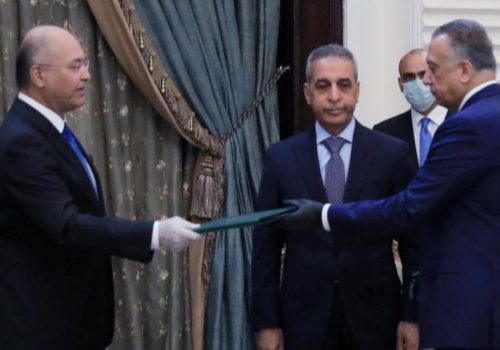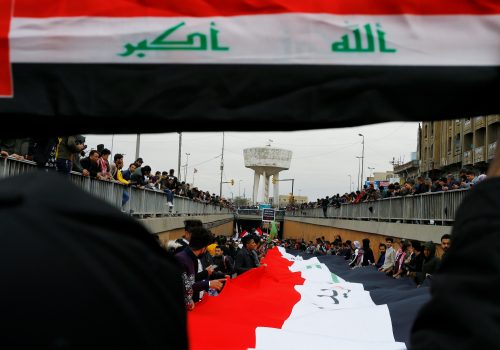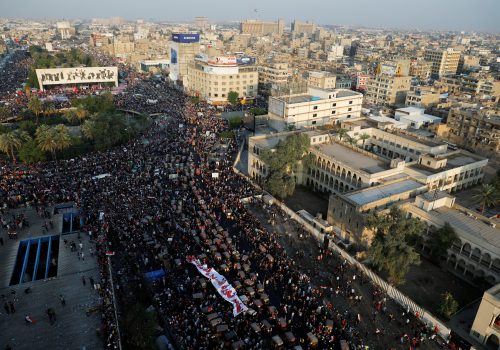Have COVID-19 and Iran tensions doomed Coalition anti-ISIS strategy?
The US-led anti-Islamic State of Iraq and al-Sham (ISIS) Coalition has been rapidly transformed by a combination of tectonic shifts in Iraq during the first months of 2020. The country has had to confront both a global outbreak as well as continued rocket fire at Iraqi bases housing Coalition troops amid US-Iran tensions. This has led to an unprecedented consolidation of US forces in Iraq and the departure of numerous European forces that were part of the anti-ISIS Coalition. It calls into question what comes next in the struggle against the terrorist group. After five years of a successful campaign against ISIS, the Coalition may be permanently crippled by tensions with Iran. Furthermore, the pandemic may serve as a convenient excuse for partners to wrap up their presence in Iraq.
In late March, Combined Joint Task Force Operation Inherent Resolve announced that it was conducting “long-planned adjustments to the force to reflect success in the campaign against [ISIS]; and, short-term moves to protect the force during the coronavirus pandemic.” The changes on the ground included the suspension of training of Iraqi Security Forces. “While the announcement was ascribed to the outbreak—which began in earnest in early March—and claimed to include “long-planned” changes, the moves took place amidst US-Iran tensions.
Throughout 2019, US-Iran tensions prompted rocket fire at bases in Iraq where Coalition personnel were present. US officials suspected Iran was behind at least ten rocket attacks last year, including the killing of a US contractor in late December. That killing led to American airstrikes on Kataib Hezbollah, which killed an estimated 25 militants, the storming of the US embassy compound in Baghdad on December 31, and Washington’s decision to assassinate Quds Force commander Qasem Soleimani and Kataib Hezbollah leader Abu Mahdi al-Muhandis on January 3.
The killings set in motion Iranian retaliatory ballistic missile attacks on two Iraqi bases housing US troops on January 8. This was followed by the killing of three members of the Coalition in a rocket attack on Camp Taji on March 11. Two Americans were also killed fighting ISIS, but it was the involvement of Iran-backed Shia militias in Iraq that most concerned US officials. The United States finally sent air defense systems in early April, including Patriot batteries, to Iraq—an arduous process made more complex by Iraq lacking a new prime minister, at the time, and Iraqi political parties ramping up opposition to US presence.
The Trump administration knows Iran tensions will continue for the foreseeable future and that means continued threats to US forces in Iraq. US President Donald Trump threatened Iran with retaliation twice in April. He has also repeatedly said he wants to end US “endless wars” in Iraq, Syria, and Afghanistan.
The US-led anti-ISIS Coalition and, with it, America’s deployment in Iraq, is now at a major turning point. The crossroads look like this:
- Increased threats to US forces in Iraq by pro-Iranian groups linked to Iraqi paramilitary forces, such as the Popular Mobilization Units.
- A political push in Iraq to demand US forces to leave. The largest political parties of Muqtada al-Sadr and Hadi al-Amiri’s Fatah Alliance are some of the most vocal proponents.
- A coronavirus pandemic that has already caused the US military to cut back training and movement.
- Increasing ISIS activity that has resulted in near daily attacks.
- Continuing Iraqi political chaos as the third prime minister-designate in three months tried and failed to form a government in late April.
The Coalition’s response to COVID-19 and Iran tensions has been to hand over facilities at six bases and posts, including Al-Qaim in Anbar province, parts of Q-West air base south of Mosul, facilities at Abu Ghraib, K-1 near Kirkuk, a Nineveh operations post near Mosul, and Taqaddum Air Base west of Baghdad. This movement consolidates the US and Coalition presence to, essentially, the large bases of Ayn al-Assad and Camp Taji, which are where the air defense system has been deployed (forces continue to be deployed in the autonomous Kurdistan region, however). The consolidation of forces means that the Coalition is in less personal contact with Iraqis who conduct day-to-day ISIS operations, such as the activity that may unfold near Mosul, in Anbar province, or near Kirkuk. It is difficult to imagine how Coalition forces will return to these bases after handing over facilities in ceremonies.
At the same time, the withdrawal of many other western Coalition partners calls into question the role of the Coalition. Canada withdrew troops between January and April; the Czech Republic personnel also departed; France said in late March that it was pulling out forces and the UK said some of its forces would depart; New Zealand, Spain, Portugal and the Netherlands removed their forces; and other Coalition partners, like Australia, have expressed concern about being drawn into a US-Iran conflict.
The emerging picture is that key elements of the Coalition have departed and halted training amid the tensions with Iran. The spread of COVID-19 helped cement those decisions as forces were withdrawn. Some of these European and NATO countries could return troops after the holy month of Ramadan in late May, depending on the virus threat and Iran tensions. They will return to a very different footprint in Iraq—one that is consolidated into a much smaller area.
The Coalition spokesperson Colonel Myles Caggins told this author that the Coalition remains in Iraq to deal with the many impacts of ISIS, and that discussions and planning for the mentoring of the Iraqi Security Forces continue with the NATO mission in Iraq. Iraqi forces are conducting operations on their own, as the Coalition’s role has shifted from carrying out a high level of raids and air strikes to sharing tactical information and securing bases. There are still limited airstrikes, such as an April 10 strike by British aircraft, and the Coalition is committed to supporting Iraq against ISIS. However, the overall posture is clear and there have never been many questions about the role of US forces after they returned to Iraq in the fall of 2014. The Coalition has no mandate to fight pro-Iranian groups in Iraq, meaning, the more Iranian tensions increase, the less willing US partners are to stay in Iraq while under rocket fire. The pandemic struck at a key time, enabling partner forces and the US to reposition under the notion that the virus was the central concern.
Can the United States claw back its role in Iraq with strategic dialogue with Baghdad, which the State Department has suggested could occur in the coming months? The current setup in the capital, with the most powerful political parties opposing the hosting of US forces, a vacuum in power due to the lack of a strong prime minister, a budget crisis with declining oil revenue, and continued US tit-for-tat threats with Tehran, do not indicate that any kind of long-term strategic discussions will be fruitful. ISIS is bound to increasingly exploit the situation.
The repercussions of the current turning point will be felt in Syria, where US forces are also located on the other side of the Iraqi border. Their position was already difficult after Washington withdrew in the face of a Turkish offensive against US Syrian Democratic Forces partners in October 2019. We could witness Iran tensions in Iraq lead to increased pressure for the US to leave, which would enable ISIS activity to increase, thereby isolating US forces in Syria.
Seth Frantzman is executive director of the Middle East Center for Reporting and Analysis, a former assistant professor at Al-Quds University and a Middle East analyst. He is the author of ‘After ISIS: America, Iran and the Struggle for the Middle East.’ Follow him on Twitter: @Sfrantzman.
Image: An Iraqi soldier wears a protective face mask and gloves, following the outbreak of coronavirus disease (COVID-19), as he stands guard during the hand over of Qayyarah Airfield West from US-led coalition forces to Iraqi Security Forces, in the south of Mosul, Iraq March 26, 2020. REUTERS/Thaier Al-Sudani


